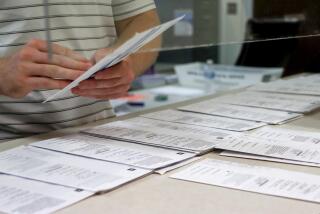California’s record-setting 224-page voter guide is costing taxpayers nearly $15 million

There’s a lot to know about the upcoming election in November, and California is doing its part to keep voters informed.
In a season replete with clothing catalogs and campaign flyers, the biggest item stuffed in mailboxes this fall may be the Nov. 8 statewide voter guide, coming in at a record-setting 224 pages.
The information booklet covers all 17 statewide ballot propositions, a document that election officials believe is the most voluminous election guide in California history. And it hasn’t come cheap: The total cost for printing and mailing, done in Sacramento and taking seven weeks to complete, will come close to $15 million.
“It could have been worse,” said Kim Alexander, president of the nonpartisan California Voter Foundation.
The qualification in late June of this fall’s large slate of statewide voter propositions, the most in more than 15 years, set in motion plans to roll out what became a hefty voter guide. State law requires the document be mailed to each of California’s 18 million voters, a two-week process that begins on Sept. 29. The printing started in the middle of August at a state government warehouse in Sacramento, and the final cost won’t be known until the effort concludes.
“On election day every voting Californian is a lawmaker,” said Secretary of State Alex Padilla.
This fall, voters are being asked to wade through some of the most complex laws ever proposed, initiatives with details so granular that they could easily confound all but the most expert legal minds.
Leading the pack is Proposition 64, the much-talked-about effort to fully legalize marijuana use for California adults. The broad question may be straightforward, but the initiative is not.
Even the guide’s overview analysis of Prop 64 is 10 pages long. The actual proposed state law to make pot legal takes another 33 pages of the document, more than 17,000 words in all.
Sign up for our daily Essential Politics newsletter »
While there have been longer lists of state propositions in the past, the accompanying guides were shorter. In the 2012 general election, California voters weighed 11 propositions. That year’s voter guide ran 144 pages and cost taxpayers $8 million.
A review of decades’ worth of voter guides, compiled online by the University of California’s Hastings School of Law, suggests the length of propositions is increasing. In 1988, for example, a much longer list of 29 ballot propositions translated into a 159-page voter guide.
Alexander said the system hands taxpayers the bill no matter what the interest groups backing the initiative measures in question choose to write.
“It might be worthwhile to consider charging initiative proponents extra to propose their measure if it exceeds a certain number of pages,” she said.
The guide is intended to offer a variety of pieces of information on ballot measures, including a quick reference guide for what Padilla described as voters “short on time” that offers ballot titles and short summaries. The guide also includes arguments in support or opposition to each proposed law as well as a fiscal analysis by the independent legislative analyst’s office.
“Many voters use the guide as a tool for quickly learning who supports and opposes a measure,” Alexander said.
Beyond Prop. 64, other propositions are hardly less dense -- from new gun control efforts to a higher tobacco tax and beyond. The two shortest, and simplest, ballot measures were the ones crafted by the Legislature: A repeal of existing restrictions on bilingual education in public schools, Proposition 58, and the advisory measure asking if state officials should work to overturn a U.S. Supreme Court ruling on campaign finance, Proposition 59.
Unlike companies that now offer consumers the option of canceling paper documents in exchange for online records, voters can’t yet opt out of receiving the state ballot guide in the mail and choose instead to read it online. A new state law, however, anticipates giving voters that option as soon as 2018 in conjunction with the certification of a new statewide voter registration database.
Because the guide is mailed to each voter in the state, some households receive multiple copies.
Some counties, like Los Angeles and San Francisco, already offer an online option for their local election documents. It could prove particularly valuable this November; San Francisco voters will have 25 local measures to ponder after they consider the 17 statewide propositions. Voters who provide an email address can stop receiving the paper brochures.
For voters overwhelmed by the weighty tome that will arrive in a few weeks, it’s always worth remembering that not every proposition requires a choice.
“We like to remind voters that voting is not a test,” said Alexander. “You don’t have to vote on every measure on the ballot, it’s perfectly fine to skip one if you are confused or unsure of how you want to vote.”
Follow @johnmyers on Twitter, sign up for our daily Essential Politics newsletter and listen to the weekly California Politics Podcast
ALSO:
Our quick guide on what you need to know about November’s 17 propositions
Early spending on this fall’s ballot measures tops $200 million
Updates on California politics
More to Read
Get the L.A. Times Politics newsletter
Deeply reported insights into legislation, politics and policy from Sacramento, Washington and beyond. In your inbox three times per week.
You may occasionally receive promotional content from the Los Angeles Times.







